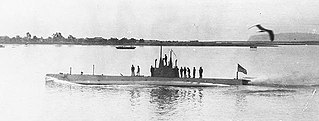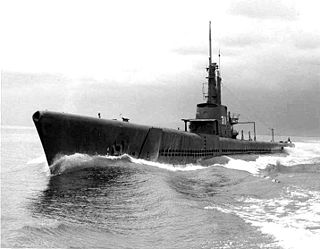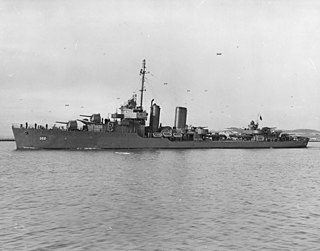
The Mare Island Naval Shipyard (MINSY) was the first United States Navy base established on the Pacific Ocean. It is located 25 miles (40 km) northeast of San Francisco in Vallejo, California. The Napa River goes through the Mare Island Strait and separates the peninsula shipyard from the main portion of the city of Vallejo. MINSY made a name for itself as the premier U.S. West Coast submarine port as well as serving as the controlling force in San Francisco Bay Area shipbuilding efforts during World War II.

USS Wyoming was the second ship of the United States Navy to bear that name, but the first to bear it in honor of the 44th state. The first Wyoming was named for Wyoming Valley in eastern Pennsylvania.

USS F-2 (SS-21) was an F-class submarine built for the United States Navy during the 1910s.

USS H-1 (SS-28), the lead ship of her class of submarine of the United States Navy, was originally named Seawolf, making her the first ship of the U.S. Navy to be named for the seawolf.

USS Volador (SS-490), a Tench-class submarine, was the second ship of the United States Navy to be named for the volador.

USS F-3 (SS-22), was a F-class submarine. She was named Pickerel when her keel was laid down by The Moran Company of Seattle, Washington, making her the first ship of the United States Navy to be named for the pickerel, a type of pike. She was renamed F-3 on 17 November 1911, launched on 6 January 1912 sponsored by Mrs. M. F. Backus, and commissioned on 5 August 1912.

USS Rainbow (AS-7) was the only ship in the United States Navy by that name. The ship was originally converted to a distilling ship in 1898, and then converted again in 1917 to a submarine tender.

USS Archerfish (SS/AGSS-311) was a Balao-class submarine. She was the first ship of the United States Navy to be named for the archerfish. Archerfish is best known for sinking the Japanese aircraft carrier Shinano in November 1944, the largest warship ever sunk by a submarine. For this achievement, she received a Presidential Unit Citation after World War II.

USS Blackfin (SS-322), a Balao-class submarine in commission from 1944 to 1948 and from 1951 to 1972, was a ship of the United States Navy named for the blackfin cisco, a food fish of the Great Lakes.

USS H-2 (SS-29) was a H-class submarine. She was originally named Nautilus, the third ship and first submarine of the United States Navy to bear the name, which was derived from a Greek word meaning "sailor" or "ship." The nautilus is also a tropical mollusk having a many-chambered, spiral shell with a pearly interior. It was also the name of the fictional submarine in Jules Verne's novel Twenty Thousand Leagues Under the Sea which was prophetic of submarine technology.

The third USS Alert was an iron-hulled screw steamer gunboat in the United States Navy. The lead ship in her class, Alert was destined for a long naval career, serving from 1875 to 1922, a period of 47 years, including service as a submarine tender in World War I. Toward the end of her career she received the designation AS-4.

USS Kanawha (AO–1) was the lead ship of her class of replenishment oilers of the United States Navy. She was commissioned in 1915 and sunk on 8 April 1943 by Japanese aircraft off Tulagi, Solomon Islands.

The third USS Worden (DD-352) was a Farragut-class destroyer in the United States Navy during World War II. She was named for John Lorimer Worden.

USS Walton (DE-361) was a John C. Butler-class destroyer escort in the United States Navy. It was named after Merrit Cecil Walton, a Marine Corps platoon sergeant with the U.S. 1st Marine Division, who died on Gavutu during the Battle of Guadalcanal and was posthumously awarded the Navy Cross for "extraordinary heroism".

The F-class submarines were a group of four submarines designed for the United States Navy by Electric Boat in 1909. F-1 and F-2 were built by Union Iron Works in San Francisco, while F-3 and F-4 were built by The Moran Company in Seattle, Washington.

USS Gilmore (DE-18) was an Evarts-class short-hull destroyer escort in the service of the United States Navy.

USS Silverstein (DE-534) was a John C. Butler-class destroyer escort in service with the United States Navy from 1944 to 1947 and from 1951 to 1958. She was sold for scrapping in 1973.

USS Kinzer (APD-91), ex-DE-232, was a United States Navy high-speed transport in commission from 1944 to 1946.

The United States Navy built permanent and temporary submarine bases around the world to maintain its fleet of submarines and serve the needs of the crews. Submarine bases are military bases that offer good fleet anchorage and are designed to refuel and resupply submarines. The peak number of US submarine bases was during World War II, as the submarine was well suited for fighting in the vast Pacific War, often in enemy waters. Many of the United States submarine bases were closed after the war.

Naval Base San Pedro and San Pedro Submarine Base were United States Navy bases at the Port of San Pedro, California officially founded in 1919. While commissioned in 1919, the Navy started operating out of the port in 1910, by renting dock space at the City of San Pedro's Dock No. 1 in 1914. The Navy had vessels stationed at the port starting in 1913. The San Pedro Submarine Base closed in 1923, with the end of World War I. Naval Base San Pedro became part of Naval Operating Base Terminal Island on 25 September 1941, which closed in 1947.























